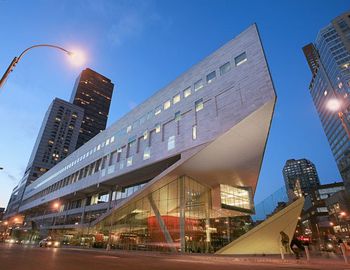

The Julliard, as it is called in New York, is certainly the best music school in the city, and it is often considered the most prominent one in the USA also. Currently it has almost one thousand students enrolled in its undergraduate and graduate music, dance and drama programs.
By the end of the 19th century Americans had realized that their cultural institutes were not meeting the standards of the time. Young people were traveling to Europe to receive their artistic and musical training, a phenomenon that was well documented in the novels of New York writer Henry James. It was clear that America just did not have the right academies to produce artists of high caliber, equal to those on the other side of the Atlantic Ocean.
One of the first major conservatories to be established in New York was the Institute of Musical Art, in 1905. In the beginning it was located on the corner of Fifth Avenue and 12th Street and five years later moved to the neighborhood of Morningside Heights, into the complex that had housed the Bloomindale Insane Asylum, not far from today's Columbia University. In 1920, thanks to an endowment from philanthropist Augustus D. Juilliard, New York saw the birth of another conservatory, the Juilliard Graduate School, on East 52nd Street. Augustus was the son of French immigrants and eventually rose to become owner of one of America's leading textile corporations. He was an influential patron of the Metropolitan Museum of Art and until his death in 1919 occupied the position of President of the Metropolitan Opera. In 1926 the Institute of Musical Art and the Juilliard Graduate School merged into one institution, the Juilliard School of Music.
One of Juilliard's most renowned and innovative presidents was William Schuman, from 1945 to 1961,who parted with the notion that traditional music theory and ear training is the foundation of musical studies. His approach was less formal, making each composer-teacher free to decide what each individual student had to concentrate on throughout his period of study. Schuman's "Literature and Materials of Music" curriculum became a very controversial method and received lots of criticism from adherents of conventional forms of music training.
By the time the Juilliard School moved from the Morningside Heights complex to the present building in Lincoln Center in 1969, it had dance and drama divisions also. Since then it grew steadily in popularity and size, and in the 1980s had its own dormitory. In 2006 the school received a collection of rare music manuscripts from patron Bruce Kovner that included autographs scores of works by Bach, Mozart, Beethoven, Chopin, Schumann, Brahms, Schubert, Liszt, Stravinsky, Ravel and others.
The programs Juilliard offers its students today are in the disciplines of music, dance and drama. The music division, the largest of the three, has majors in voice, woodwind instruments, strings, piano, percussion, organ, orchestral conducting, jazz studies, harp, guitar, composition, collaborative piano and brass instruments. Students can receive degrees such as the Bachelor of Music, the Master of Music or Graduate Diploma, or the Doctor of Musical Arts, corresponding to the three levels available in most universities. The drama division gives out the Bachelor and Master of Fine Arts in acting and the dance department only the Bachelor.
The Juilliard also has a pre-college music division, in which elementary, middle school and high school students study music theory, as well as their chosen instruments. It even has two pre-college orchestras, the Pre-College Symphony and the Pre-College Orchestra. Most students enrolled in the pre-college program go on to study at least in the school's undergraduate programs.
Admission into this cream of the crop performing arts school is extremely competitive, with an average of eight percent of applicants being admitted, which means that there is not even one free space for ten applicants. The annual tuition is approximately $50,000. Juilliard also receives millions, if not even hundreds of millions, of dollars in annual funding. Famous instructors have included opera diva Maria Callas and jazz great Wynton Marsalis.